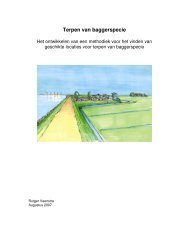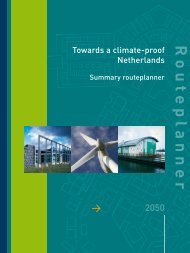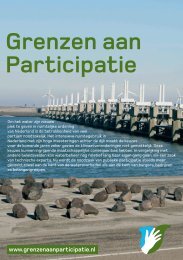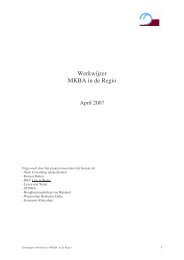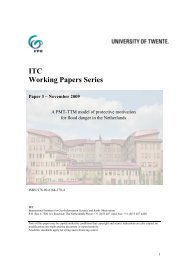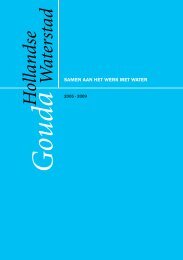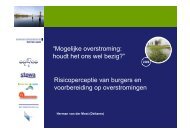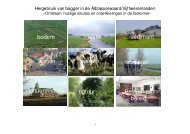Deltas on the move; Making deltas cope with the effects of climate c
Deltas on the move; Making deltas cope with the effects of climate c
Deltas on the move; Making deltas cope with the effects of climate c
- No tags were found...
Create successful ePaper yourself
Turn your PDF publications into a flip-book with our unique Google optimized e-Paper software.
KvR report 001/2006Figure 8:populati<strong>on</strong> flooded in 2100 (Nx1000/y)40302010Populati<strong>on</strong> at risk and land lost in 2100 as a functi<strong>on</strong> <strong>of</strong> two scenariosaccording to DIVA simulati<strong>on</strong>s.Stocks at riskThe DIVA indicators <strong>of</strong> coastal populati<strong>on</strong> density and ec<strong>on</strong>omic activity value (asGDP) show substantial variability am<strong>on</strong>g <strong>the</strong> <strong>deltas</strong> covered (Figure 7). Lifeexpectancy appears to be extrapolated straight from GDP in DIVA, since <strong>the</strong>explained variance <strong>of</strong> our subset was 100%. Dike height and tourist arrivals (in 1995)show clear co-variability <strong>with</strong> GDP (and hence life expectancy). Whereas estimatedland loss in 2100 correlated well to land loss in 2000, <strong>the</strong> estimated populati<strong>on</strong>flooded and hence people estimated to suffer serious losses did not covary wellacross time: overall, less people were estimated to be flooded in 2100, probablybecause DIVA assumes that ec<strong>on</strong>omically feasible measures will be taken or landwill be evacuated when submerged in sea. The overall pattern when comparing <strong>the</strong>two scenarios is that under A2 sea level rise will be more serious and hence allc<strong>on</strong>sequences as well. Overall, it can be c<strong>on</strong>cluded that <strong>the</strong> following socioec<strong>on</strong>omicvariables from DIVA <strong>of</strong>fer useful variability am<strong>on</strong>g <strong>deltas</strong>: coastalpopulati<strong>on</strong>, GDP, dike height and possibly tourist arrivals. The distincti<strong>on</strong> in futuredevelopment according to scenarios also makes a sensible difference.Figure 9:00 40 80 120 16040000populati<strong>on</strong> flooded in 2000 (Nx1000/y)A2B1direct land loss in 2100 (km 2 /y)00 0.2 0.4 0.6DIVA indicators that can be used to assess <strong>the</strong> potential for s<strong>of</strong>tengineering measures1.61.20.80.415000A2B1direct land loss in 2000 (erosi<strong>on</strong>, km 2 /y)<str<strong>on</strong>g>Deltas</str<strong>on</strong>g> <strong>on</strong> <strong>the</strong> <strong>move</strong>Potential for s<strong>of</strong>t engineeringSeveral possibly useful indicators have been sorted to allow a detailed check-up (seebelow). Obvious variables were sediment supply and accommodati<strong>on</strong> space(SEDSUP and ASPACE), but <strong>on</strong>ly accommodati<strong>on</strong> space was found to differentiatebetween <strong>deltas</strong> (Figure 5). O<strong>the</strong>r variable should be <strong>the</strong> area <strong>of</strong> low coastal plains(for example < 1 m above sea level), and <strong>the</strong> slope across <strong>the</strong> coastline. Both displaysubstantial variati<strong>on</strong> am<strong>on</strong>g <strong>deltas</strong> (Figure 9). Steep coastal slopes generally haveless coastal plains, but <strong>the</strong> scatter remains substantial. The highest number <strong>of</strong>people potentially flooded occurred in Bangladesh (Figure 9 right panel, <strong>the</strong> outlier)in a comparatively small coastal plain.DIVA- indicators combinedA principal comp<strong>on</strong>ents analysis <strong>of</strong> all DIVA indicators combined for <strong>the</strong>se 34 <strong>deltas</strong>suggested that three major axes toge<strong>the</strong>r explained a significant part (52%) <strong>of</strong> <strong>the</strong>total variati<strong>on</strong>. The first axis correlated to storm surge indicators, and explained 21%.The sec<strong>on</strong>d axis (additi<strong>on</strong>al 19%) was related to lowland areas in <strong>the</strong> coastal plaincharacteristics, and <strong>the</strong> third axis related to <strong>the</strong> populati<strong>on</strong> that was potentiallyflooded (additi<strong>on</strong>al 12%). Fur<strong>the</strong>r comp<strong>on</strong>ents added little to <strong>the</strong> explained varianceand were not str<strong>on</strong>gly correlated to any <strong>of</strong> <strong>the</strong> underlying individual variables.Notably, <strong>the</strong> populati<strong>on</strong> that would actually be flooded in 2100 under scenario A2correlated str<strong>on</strong>gly to PCA-axis 1. Thus, physical (axes 1, 2) and socio-ec<strong>on</strong>omicindicators (axis 3) do span across different dimensi<strong>on</strong>s in <strong>the</strong> DIVA database. Thisjustifies a separate inclusi<strong>on</strong> <strong>of</strong> <strong>the</strong>se types <strong>of</strong> indicators and supports our initialdistincti<strong>on</strong> in three categories <strong>of</strong> indicators.Single linear correlati<strong>on</strong>s am<strong>on</strong>g <strong>the</strong> many variables used here support <strong>the</strong> overallpattern <strong>of</strong> <strong>the</strong> PCA: several clusters <strong>of</strong> variables exist. Table 2 <strong>on</strong>ly reports <strong>the</strong> mostoutstanding and significant (p>0.05) correlati<strong>on</strong>s. Most projecti<strong>on</strong>s for scenarios A2and B1 also correlate well <strong>with</strong> <strong>the</strong> values estimated for 2000. This c<strong>on</strong>firms <strong>the</strong>pattern <strong>of</strong> Fig 8. Lowland areas available in deltaic coastal segments correlate well,so when <strong>the</strong>re is a large area below 1 m AMSL, <strong>the</strong>n <strong>the</strong> same holds for 2, 3 and 4 melevati<strong>on</strong>s. Since scenario-based indicators <strong>of</strong> stock at risk were found to covaryclosely, we propose to use <strong>the</strong> estimates for 2000, and maybe use <strong>the</strong> B1 and A2scenario outcomes as an indicator <strong>of</strong> possible band <strong>with</strong> <strong>of</strong> future developments. It isnoteworthy, that indeed <strong>the</strong> B1-scenario, geared towards a sustainability-orientedworld, would lead to lower mortality estimates and lower sea level rise.coastal plain (area lower than 1 m ASL)30000200001000000 0.2 0.4 0.6 0.8 1people potentially flooded(x1000, in 2000, prescenario run)10000500001 10 100 1000 10000 1000003 Combining WDD and DIVA indicatorsWDD gives an accurate physical descripti<strong>on</strong> <strong>of</strong> <strong>deltas</strong> and <strong>the</strong> processes that arebuilding and c<strong>on</strong>tinuously changing <strong>the</strong>ir form. DIVA incorporates and produces amuch larger set <strong>of</strong> variables. Where <strong>the</strong> two datasets provide similar variables (meanannual discharge, tidal regime), <strong>the</strong>se correlate well, which is a comfortingobservati<strong>on</strong>. We chose to keep such pairs <strong>of</strong> variables, as well as most o<strong>the</strong>rs thatmight be useful for potential future users. Therefore <strong>the</strong> indicator database is rich invariables.coastal slope (degrees perpendicular <strong>on</strong>coastline)coastal plain (area below 1 m ASL)9293



